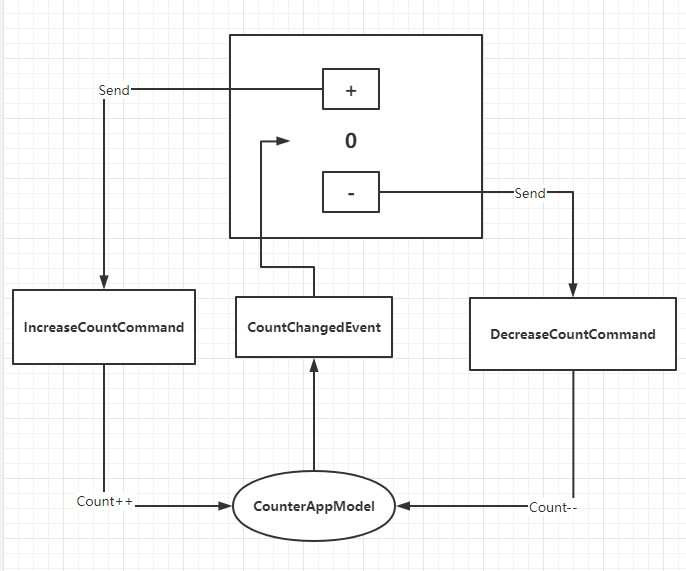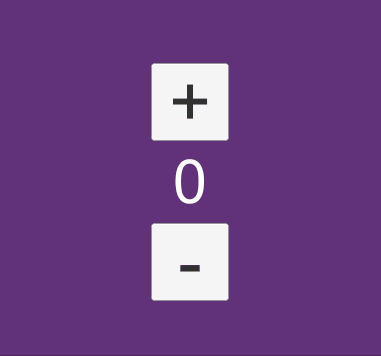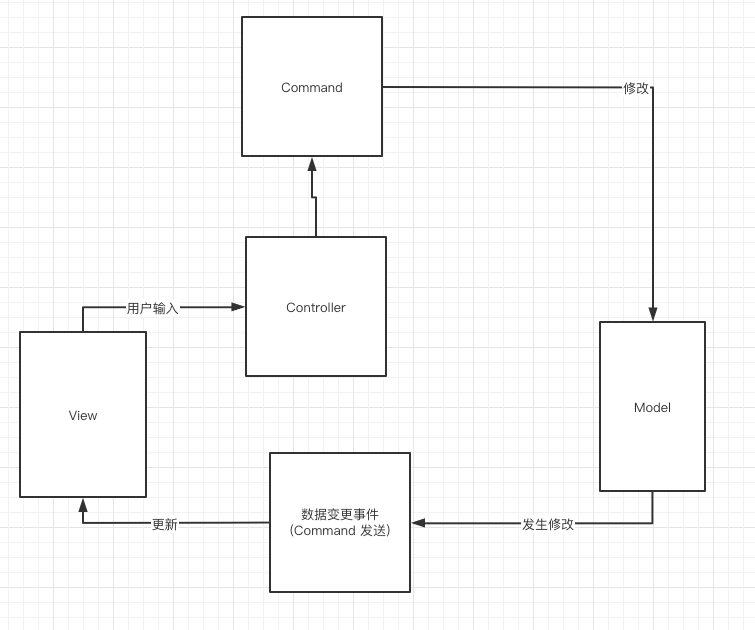我们看下当前的代码:
using UnityEngine;
using UnityEngine.UI;
namespace QFramework.Example
{
// 1. 定义一个 Model 对象
public class CounterAppModel : AbstractModel
{
public int Count;
protected override void OnInit()
{
Count = 0;
}
}
// 2.定义一个架构(提供 MVC、分层、模块管理等)
public class CounterApp : Architecture<CounterApp>
{
protected override void Init()
{
// 注册 Model
this.RegisterModel(new CounterAppModel());
}
}
// 引入 Command
public class IncreaseCountCommand : AbstractCommand
{
protected override void OnExecute()
{
this.GetModel<CounterAppModel>().Count++;
}
}
public class DecreaseCountCommand : AbstractCommand
{
protected override void OnExecute()
{
this.GetModel<CounterAppModel>().Count--;
}
}
// Controller
public class CounterAppController : MonoBehaviour , IController /* 3.实现 IController 接口 */
{
// View
private Button mBtnAdd;
private Button mBtnSub;
private Text mCountText;
// 4. Model
private CounterAppModel mModel;
void Start()
{
// 5. 获取模型
mModel = this.GetModel<CounterAppModel>();
// View 组件获取
mBtnAdd = transform.Find("BtnAdd").GetComponent<Button>();
mBtnSub = transform.Find("BtnSub").GetComponent<Button>();
mCountText = transform.Find("CountText").GetComponent<Text>();
// 监听输入
mBtnAdd.onClick.AddListener(() =>
{
// 交互逻辑
this.SendCommand<IncreaseCountCommand>();
// 表现逻辑
UpdateView();
});
mBtnSub.onClick.AddListener(() =>
{
// 交互逻辑
this.SendCommand<DecreaseCountCommand>();
// 表现逻辑
UpdateView();
});
UpdateView();
}
void UpdateView()
{
mCountText.text = mModel.Count.ToString();
}
// 3.
public IArchitecture GetArchitecture()
{
return CounterApp.Interface;
}
private void OnDestroy()
{
// 8. 将 Model 设置为空
mModel = null;
}
}
}
我们通过引入了 Command 来帮助 Controller 分担了一部分的交互逻辑。
但是表现逻辑的代码目前看起来并不是很智能。
表现逻辑的代码如下:
// 监听输入
mBtnAdd.onClick.AddListener(() =>
{
// 交互逻辑
this.SendCommand<IncreaseCountCommand>();
// 表现逻辑
UpdateView();
});
mBtnSub.onClick.AddListener(() =>
{
// 交互逻辑
this.SendCommand<DecreaseCountCommand>();
// 表现逻辑
UpdateView();
});
每次调用逻辑之后,表现逻辑部分都需要手动调用一次(UpdateView 方法)。
在一个项目中,表现逻辑的调用次数,至少会和交互逻辑的调用次数一样多。因为只要修改了数据,对应地就要把数据的biang在界面上表现出来。
而这部分嗲用表现逻辑的代码也会很多,所以我们引入一个事件机制来解决这个问题。
这个事件机制的使用其实是和 Command 一起使用的,这里有一个简单的小模式,如下图所示:

即通过 Command 修改数据,当数据发生修改后发送对应的数据变更事件。
这个是简化版本的 CQRS 原则,即 Command Query Responsibility Separiation,读写分离原则。
引入这项原则会很容易实现 事件驱动、数据驱动 架构。
在 QFramework 中,用法非常简单,代码如下:
using UnityEngine;
using UnityEngine.UI;
namespace QFramework.Example
{
// 1. 定义一个 Model 对象
public class CounterAppModel : AbstractModel
{
public int Count;
protected override void OnInit()
{
Count = 0;
}
}
// 2.定义一个架构(提供 MVC、分层、模块管理等)
public class CounterApp : Architecture<CounterApp>
{
protected override void Init()
{
// 注册 Model
this.RegisterModel(new CounterAppModel());
}
}
// 定义数据变更事件
public struct CountChangeEvent // ++
{
}
// 引入 Command
public class IncreaseCountCommand : AbstractCommand
{
protected override void OnExecute()
{
this.GetModel<CounterAppModel>().Count++;
this.SendEvent<CountChangeEvent>(); // ++
}
}
public class DecreaseCountCommand : AbstractCommand
{
protected override void OnExecute()
{
this.GetModel<CounterAppModel>().Count--;
this.SendEvent<CountChangeEvent>(); // ++
}
}
// Controller
public class CounterAppController : MonoBehaviour , IController /* 3.实现 IController 接口 */
{
// View
private Button mBtnAdd;
private Button mBtnSub;
private Text mCountText;
// 4. Model
private CounterAppModel mModel;
void Start()
{
// 5. 获取模型
mModel = this.GetModel<CounterAppModel>();
// View 组件获取
mBtnAdd = transform.Find("BtnAdd").GetComponent<Button>();
mBtnSub = transform.Find("BtnSub").GetComponent<Button>();
mCountText = transform.Find("CountText").GetComponent<Text>();
// 监听输入
mBtnAdd.onClick.AddListener(() =>
{
// 交互逻辑
this.SendCommand<IncreaseCountCommand>();
});
mBtnSub.onClick.AddListener(() =>
{
// 交互逻辑
this.SendCommand(new DecreaseCountCommand(/* 这里可以传参(如果有) */));
});
UpdateView();
// 表现逻辑
this.RegisterEvent<CountChangeEvent>(e =>
{
UpdateView();
}).UnRegisterWhenGameObjectDestroyed(gameObject);
}
void UpdateView()
{
mCountText.text = mModel.Count.ToString();
}
// 3.
public IArchitecture GetArchitecture()
{
return CounterApp.Interface;
}
private void OnDestroy()
{
// 8. 将 Model 设置为空
mModel = null;
}
}
}
代码很简单。
流程图如下:

运行结果如下:

引入事件机制 和 CQRS 原则之后,我们的表现逻辑的代码变少了很多。
由原来的两次主动调用
// 监听输入
mBtnAdd.onClick.AddListener(() =>
{
// 交互逻辑
this.SendCommand<IncreaseCountCommand>(); // 没有参数构造的命令支持泛型
// 表现逻辑
UpdateView();
});
mBtnSub.onClick.AddListener(() =>
{
// 交互逻辑
this.SendCommand(new DecreaseCountCommand()); // 也支持直接传入对象(方便通过构造传参)
// 表现逻辑
UpdateView();
});
变成了一处监听事件,接收事件进行调用。
// 监听输入
mBtnAdd.onClick.AddListener(() =>
{
// 交互逻辑
this.SendCommand<IncreaseCountCommand>(); // 没有参数构造的命令支持泛型
});
mBtnSub.onClick.AddListener(() =>
{
// 交互逻辑
this.SendCommand(new DecreaseCountCommand()); // 也支持直接传入对象(方便通过构造传参)
});
UpdateView();
// 表现逻辑
this.RegisterEvent<CountChangeEvent>(e =>
{
UpdateView();
}).UnRegisterWhenGameObjectDestroyed(gameObject);
这样减缓了很多交互逻辑。
OK,到此,我们算是用上了还算合格的 MVC 的实现,而 QFramework 所提供的概念中,最重要的概念已经接触到了,即 CQRS,通过 Command 去修改数据,数据发生修改后发送数据变更事件。
当前的示意图如下:

学到这里,对于 QFramework 架构的使用算是真正的入门了。
不过接下来还有一些概念,我们下一篇继续。
更多内容
- 转载请注明地址:liangxiegame.com (首发) 微信公众号:凉鞋的笔记
- QFramework 主页:qframework.cn
- QFramework 交流群: 623597263
- QFramework Github 地址: https://github.com/liangxiegame/qframework
- QFramework Gitee 地址:https://gitee.com/liangxiegame/QFramework
- GamePix 独立游戏学院 & Unity 进阶小班地址:https://www.gamepixedu.com/